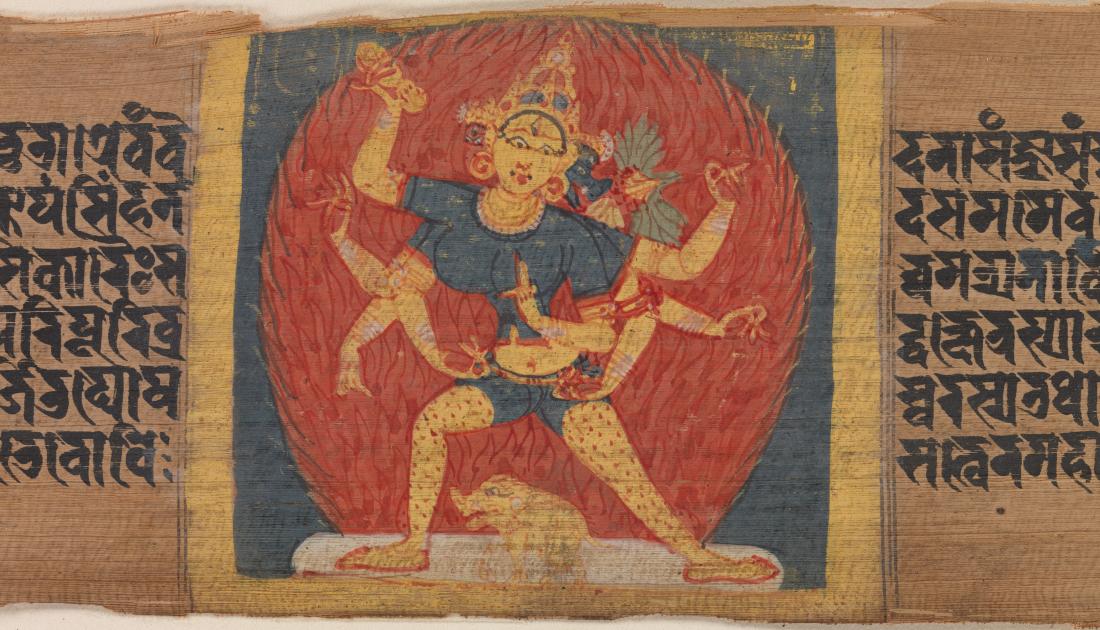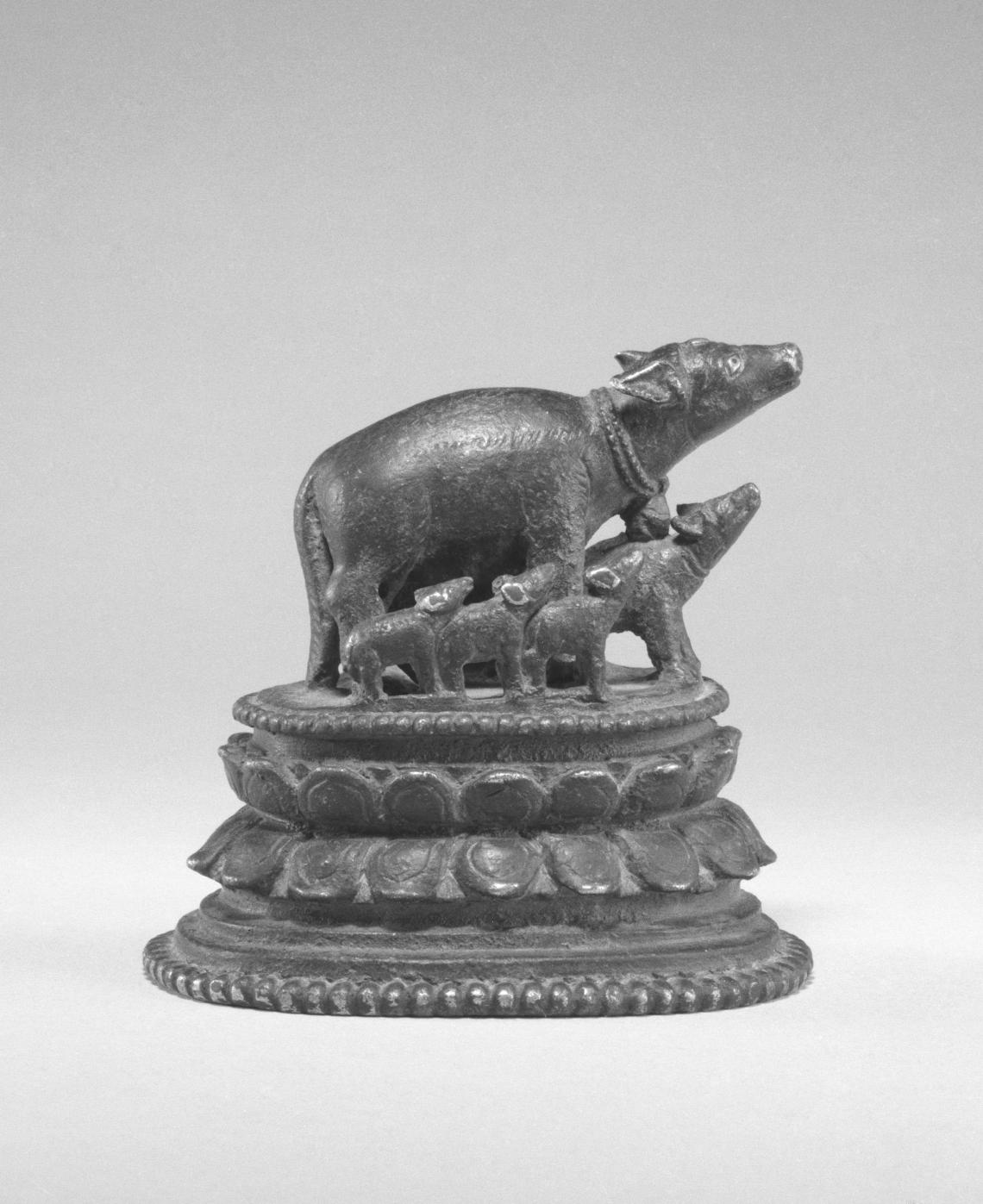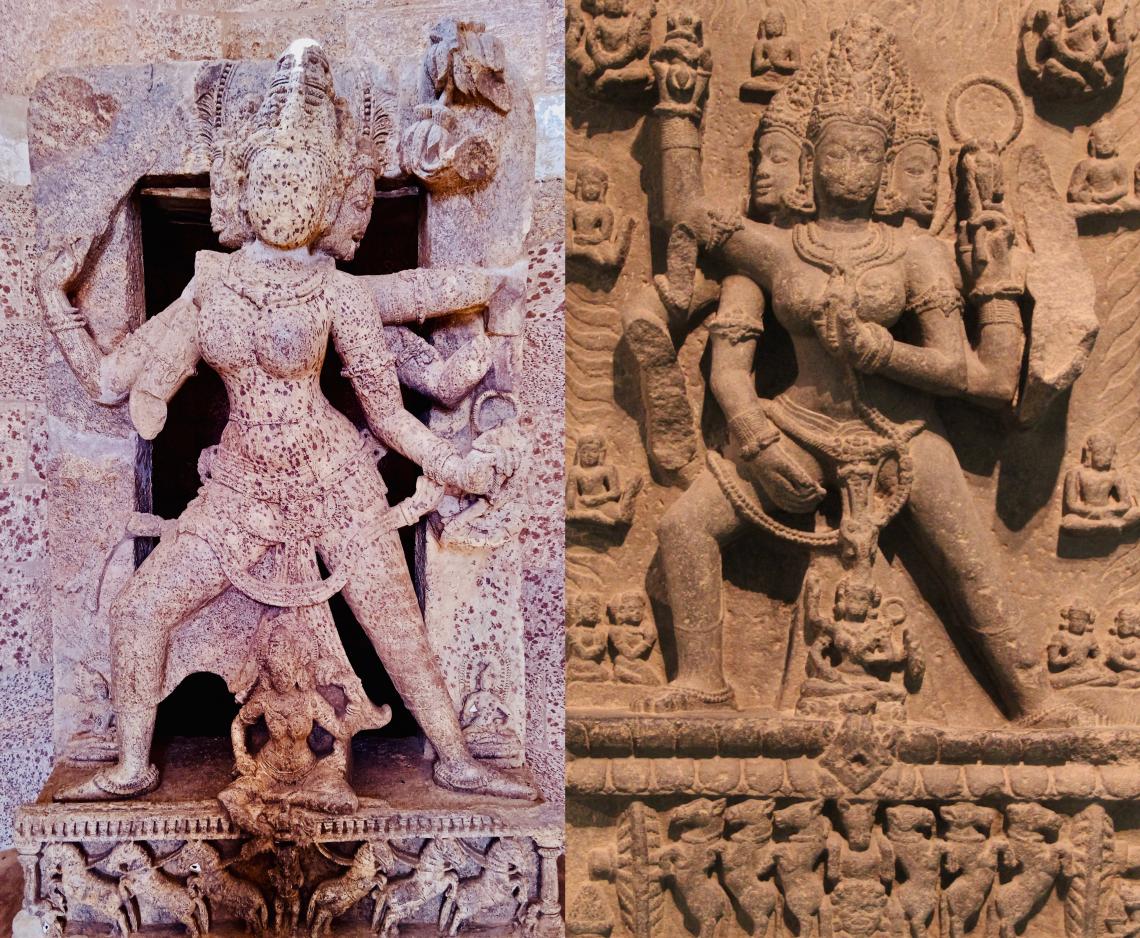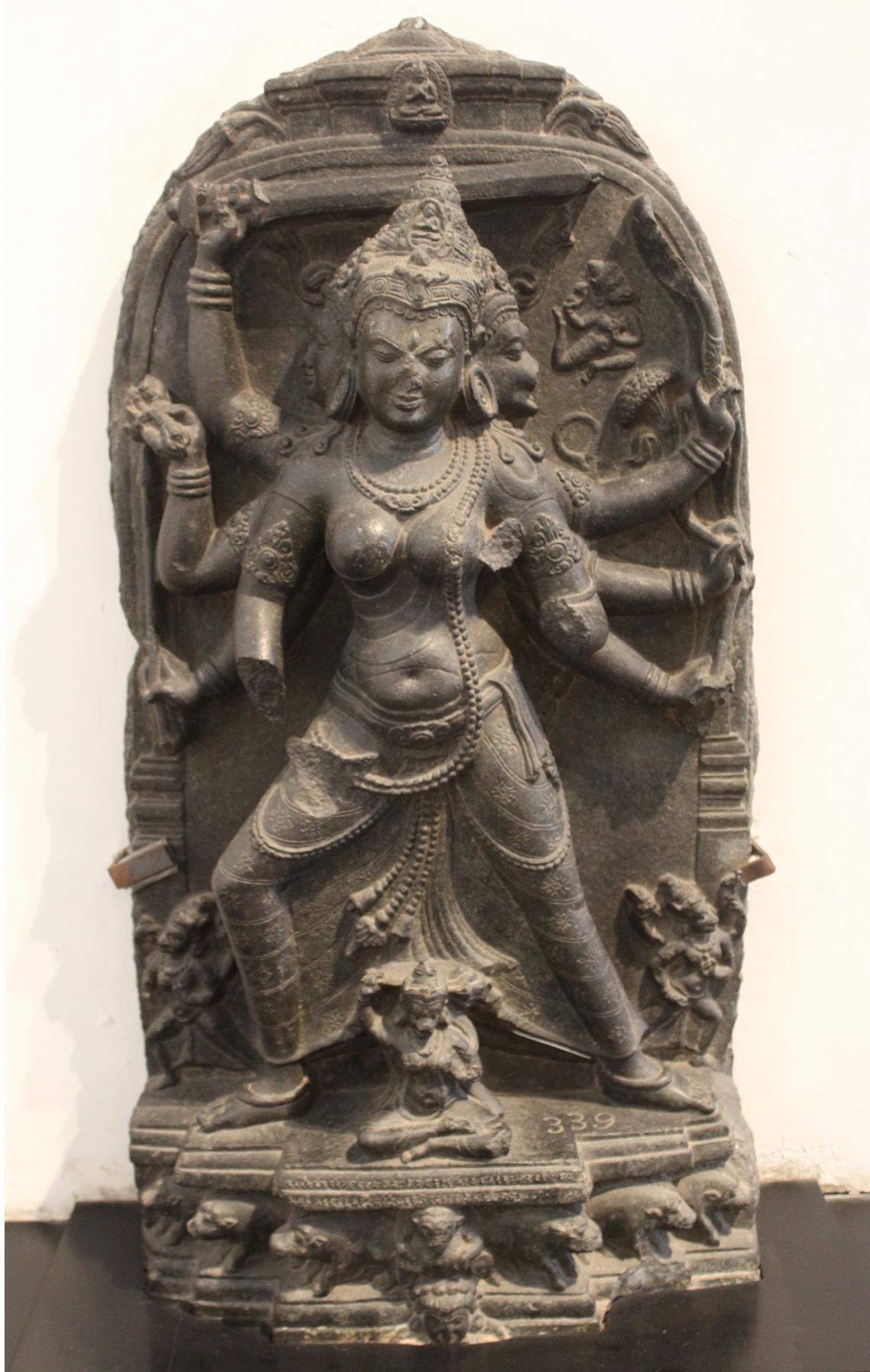Wrathful Eight-armed and Three-faced Goddess Tara Marichi, Leaf from a dispersed Pancavimsatisahasrika Prajnaparamita Manuscript, Pala, Undivided Bengal, c. 1090, Opaque watercolour on palm leaf, 5.7 x 57.2 cm.
A Buddhist deity and a bodhisattva, Marichi is seen as a remover of darkness, obstacles and evil, as symbolised in her association with light, the sun and various weapons. She has been commonly depicted as a tantric protector deity and Goddess of the Dawn among Buddhist cultures in India, China and Tibet, and as far as Korea, Mongolia and Thailand. She is invoked in Tibet at sunrise as a spiritual destroyer of darkness, and for protection. In Japan, where she is revered as a protective figure for warriors, she is worshipped as Marishiten. Represented in diverse forms over time and across regions — from a two-armed attendant to the saviour deity Tara, to an independent warrior deity with many heads and arms — Marichi images are distinguished by the motif of the boar or sow, appearing as one of her faces or as her vehicle.
Marichi, the Goddess of Dawn, with seven pigs, Pala, Bihar, c. 11th or 12th century, Bronze with silver inlay, 6.7 cm.
She is most commonly depicted holding an ashoka branch, a vajra, a needle and thread — the latter functioning as a weapon to sew closed the eyes and mouths of evildoers. In various depictions she also holds a bow and arrow, sword, noose, elephant goad and mace, among other implements. As the bringer of light, she is also shown holding the Sun in one or more hands. She may take a placid form with a single face and two arms, or be depicted with three or more faces — including a placid, a wrathful and a boar-face — and up to twelve arms, reminiscent of Hindu goddesses Durga and Varahi. She is typically depicted in a dynamic standing pose with her legs wide apart in the heroic or militant pratyalidha pose — the right leg bent and left leg outstretched. One of her hands takes the threatening tarjani mudra. She is commonly presented with yellow or red skin, and rarely white-complexioned. In other depictions similar to those of the Hindu Sun god, she is shown in a chariot with seven boars or sows as her steeds (instead of horses); occasionally she is seated on a lotus atop a single sow. In rare instances Marichi is represented in zoomorphic form as a sow.
While scholars are unable to attribute a singular origin to the goddess, she is variously thought to have evolved from nature spirits, Vedic solar gods such as Surya and Ushas, the Iranian solar deity cult related to Mithra, or the cult of martial goddesses that includes Chandi, Devi and Shakti, worshipped in India from the fifth century onwards. The earliest images found of Marichi are relief sculptures that date to the first and second century BCE. Steles that depict the goddess resembling a yakshi or a benign tree-spirit have been found in the important Buddhist sites of Bharhut, Sanchi and Nagarjunakonda. Here she is seen holding an ashoka twig in one hand and a sword or noose in the other.
(Left to right) Marichi, Andhra Pradesh, Photographer: G.N Subrahmanyam, c. 4th– 9th century; Marichi, Eastern India, Photographer: Gary Todd, c. 12th century.
Descriptions of Marichi are found in Sanskrit philosophical texts, and sutras such as the Vedas and the Bhagavad Gita. The Sadhanamala, a seminal Buddhist instructional manual on meditation compiled between the fifth and twelfth centuries CE, describes six distinct forms of Marichi, with varying numbers of heads and arms — one, three, five or six heads, and two, eight, ten or twelve arms. In artwork from twelfth-century illustrated manuscripts from southern Bengal (parts of present-day Bangladesh and West Bengal) Marichi is depicted with yellow skin and three eyes. She appears first as a two-armed deity and later as a more fierce three-faced, eight-armed one with a tall crown, facing Tara. In both illustrations, she stands in a pratyalidha lunge bearing an ashoka twig and a vajra, against a flaming orb that functions as a full-body halo. These elements comprise some of the most prevalent in Marichi iconography.
While her early, two-armed attendant form is known as Ashokakanta, meaning ‘the maiden of the ashoka tree’, the six- or eight-armed warrior goddess form constitutes the Kalpoktam Marichi representation. Besides her appearances in these forms in manuscript illustrations, Marichi was also depicted as the Goddess of Dawn from the ninth and tenth centuries in eastern India, with such images found from Ratnagiri and Bodh Gaya as well as other Buddhist sites in Bihar, West Bengal, Odisha and parts of Nepal.
Marichi, Bihar, Photographer: Suvadip Sanyal, c. 9th century, Chlorite.
Following the translation of the Sanskrit texts into Tibetan and Chinese from the tenth century onwards, Indian Buddhist figures made their way into Tibetan tantric Buddhism. Marichi began to occupy a place of growing importance here, appearing as the central deity in the Nishpannayogavali mandala where she is surrounded by her female attendants Varttali, Vadali, Varali and Varihamukhi. In light of the influence of the Mahayoga- and yogini tantras in the twelfth century, Marichi acquires her most elaborate form as a terrifying, wrathful deity. Referred to as the Oddiyana Marichi in this form, she has red skin, ten or twelve arms bearing weapons, and a pot belly, resembling other powerful tantric goddesses, Vajravarahi and Parnashavari.
While these tantric manifestations of Marichi were popular, the most prevalent representations are the two-armed Ashokakanta Marichi and the yellow-skinned, multi-armed Kalpoktam Marichi. The Kalpoktam Marichi is seen in thangkas and bronze statues from the twelfth century onwards as a peaceful as well as wrathful deity. Sometimes shown with a stupa adorning her head, she is seen being driven by a chariot of sows or seated on a singular boar. This particular manifestation is also popular in China (in both Buddhism and Taoism) and Japan, as a minor warrior goddess.
As a bodhisattva, Marichi is a symbol of rapid enlightenment, and is sometimes also associated with astrology due to her association with the sun. While she continues to be deified in Tibet, China and Japan, her importance has declined in India and Nepal.
This article first appeared in the MAP Academy Encyclopedia of Art.
The MAP Academy is a non-profit online platform consisting of an Encyclopedia of Art, Courses and Stories, that encourages knowledge building and engagement with the visual arts and histories of South Asia. Our team of researchers, editors, writers and creatives are united by a shared goal of creating more equitable resources for the study of art histories from the region.






